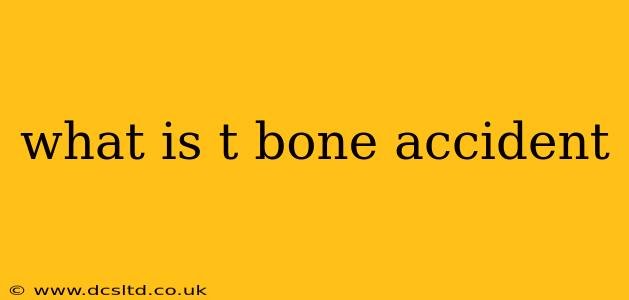A T-bone accident, also known as a side-impact collision, is a type of car accident where the front of one vehicle collides with the side of another. This typically occurs at an intersection when one vehicle runs a red light, stop sign, or fails to yield the right-of-way, striking the side of another car that is proceeding through the intersection legally. The impact resembles the shape of the letter "T," hence the name. These collisions are notoriously dangerous due to the significant forces involved and the lack of protection offered to the side of a vehicle compared to its front.
Why are T-Bone Accidents so Dangerous?
The severity of a T-bone accident stems from several factors:
- Impact Location: The side of a vehicle offers considerably less structural support than the front. The impact often occurs in areas with fewer reinforcements, leading to greater intrusion into the passenger compartment.
- Force of Impact: The momentum of the striking vehicle is transferred directly to the side of the impacted car, often resulting in significant damage and injuries. The lack of crumple zones designed to absorb impact on the side exacerbates this.
- Passenger Vulnerability: Passengers in the vehicle struck on the side are at a significantly increased risk of serious injury. They often lack the same level of protection offered by airbags and seatbelts designed for frontal collisions.
What are the Common Causes of T-Bone Accidents?
Several factors contribute to the high incidence of T-bone accidents:
- Driver Distraction: Driving while distracted, whether by cell phones, navigation systems, or other in-car activities, is a major contributing factor. Distracted drivers may fail to notice other vehicles or signals, leading to a collision.
- Running Red Lights or Stop Signs: Failing to obey traffic signals is a common cause, as is disregarding the right-of-way.
- Impaired Driving: Driving under the influence of alcohol or drugs significantly impairs judgment and reaction time, dramatically increasing the risk of a T-bone accident.
- Blind Spots: Large vehicles, such as trucks and SUVs, can have significant blind spots that make it difficult for drivers to see smaller vehicles approaching from the side.
- Failure to Yield: Failing to yield the right-of-way at intersections or when merging lanes is a frequent cause of T-bone collisions.
What Injuries are Common in T-Bone Accidents?
Injuries sustained in T-bone accidents can range from minor to life-threatening. Common injuries include:
- Head Injuries: Concussions, brain injuries, and skull fractures are frequent, often due to the lack of side impact protection.
- Neck and Spinal Cord Injuries: Whiplash and other spinal injuries are common, especially in impacts at higher speeds.
- Chest Injuries: Rib fractures, lung injuries, and heart damage are possible.
- Pelvic Injuries: Fractures and internal injuries to the pelvic region are common.
- Leg and Foot Injuries: These can range from sprains and fractures to more severe crush injuries.
How Can I Avoid a T-Bone Accident?
Preventing T-bone accidents requires vigilance and responsible driving habits:
- Always Pay Attention: Eliminate distractions while driving and focus on the road ahead.
- Obey Traffic Signals: Always stop at red lights and stop signs and yield the right-of-way when required.
- Check Your Blind Spots: Always check your blind spots before making any lane changes or turns.
- Drive Defensively: Assume other drivers may make mistakes and be prepared to react accordingly.
- Never Drive Impaired: Avoid driving under the influence of alcohol or drugs.
What should I do if I am involved in a T-bone accident?
If you're involved in a T-bone accident, your immediate priorities are safety and documentation. This includes:
- Check for Injuries: Assess the condition of yourself and any passengers. Seek immediate medical attention if necessary.
- Call Emergency Services: Report the accident to the police and request medical assistance.
- Gather Information: Collect information from the other driver, including their insurance details, driver's license, and contact information. Obtain the names and contact information of any witnesses.
- Document the Scene: Take photos and videos of the damage to both vehicles, the accident scene, and any visible injuries.
Understanding the nature of T-bone accidents, their causes, and the steps to avoid them is crucial for improving road safety. Remember that defensive driving and attentiveness are paramount in minimizing the risk of this dangerous type of collision.
